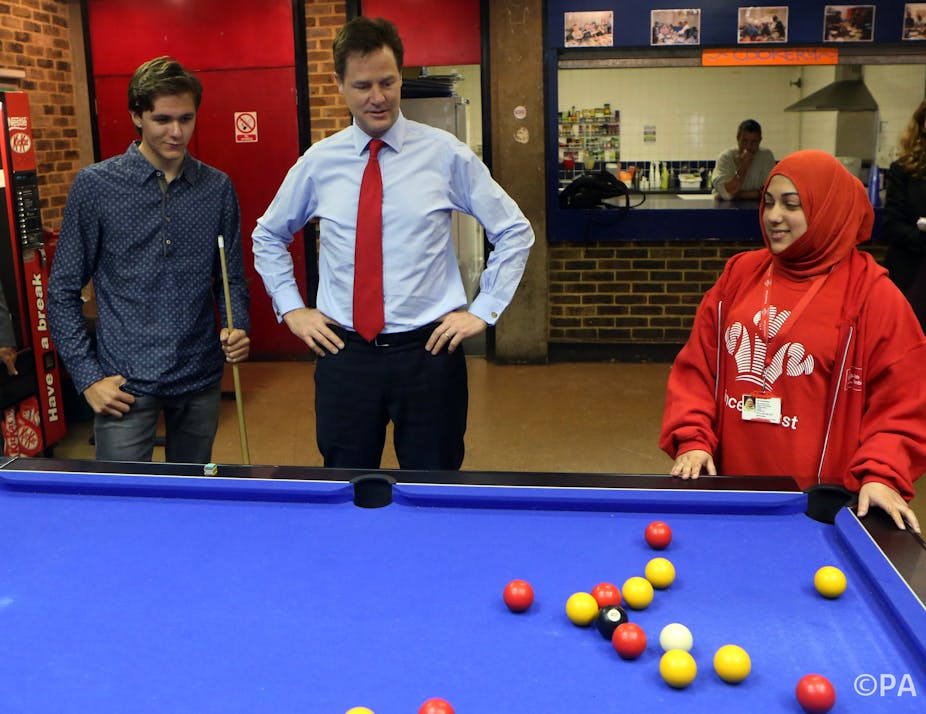When the Youth Contract was launched in 2012, it was described by deputy prime minister Nick Clegg as “a major moment for Britain’s unemployed young people”. With an overall budget of £1bn, the plan was to provide training, help with interviews and work experience for half a million young people.
A key component of the scheme would be a £2,275 incentive to employers for each unemployed young person they took on for six months as a “job start”. Now, two years after the official launch of the programme in June 2012, this wage-incentive element is to be abandoned.
The decision has been attributed to a reduction in the level of youth unemployment. This will enable the money not spent on the programme to be concentrated on supporting young people from specific target groups. Given that, as of November 2013, only 10,000, or 6.3% of the incentivised employer places had been taken up, there is certainly a considerable “underspend” to be used elsewhere.
It is also true that there has been another reduction in the number of young people who are classified as NEET – not in education, employment or training. Among 16 to 24-year-olds, the proportion classified as NEET fell from 15.5% between March and July 2013 to 13.6% in the equivalent months in 2014. There were 955,000 16 to 24-year-olds unemployed.
No room for complacency
Nonetheless, this is still nearly one million young people officially being classified as NEET. With only half of that population being defined as “actively seeking work”, we cannot afford to be complacent about these figures, nor sanction the withdrawal of programmes without the introduction of any alternatives for all young NEET people.
The Youth Contract policy spans two government departments: the Department for Work and Pensions is responsible for the 18 to 24-year-old element and the Department for Education manages the programme for 16 and 17-year-olds. The policy aims to assist young people who are NEET through a payments-by-results and “black box” delivery model. This focuses on devolved management through a supply chain of providers whose payments are dependent on young people being placed into sustained positive outcomes – either a education or training course, or a job.
As far as the Youth Contract for 16 to 17-year-olds is concerned, take-up was slower than anticipated, as the graph below shows. This was due, in part, to the eligibility criteria being confined to those young people with no GCSEs A* to C (original cohort in the graph below). From January 2013, this was broadened to include those with one GCSE at that grade, young offenders and young people in or leaving care, regardless of their qualification status (extended cohort in the graph). But the extension has not significantly increased volumes.

Another factor was the back-loaded payment system which was overly reliant on the delivery of “hard” outcomes, in this case sustained participation in education, employment or training. Some providers questioned the financial viability of the delivery model, as many Youth Contract participants failed to progress to education, employment or training provision in the required time period.
Questions over payment-by-results
While the performance of the Youth Contract has clearly fallen well short of expectations, valuable lessons can be learned. The first of these concerns the programme design, with very serious questions being raised about the efficacy of a payment-by-results model, which, in this case, has demonstrably failed. Most of the providers said there was insufficient funding available up-front to support the recruitment process and the intensive work needed to develop soft skills in young people.
Second, the measurement of programme performance solely in terms of “hard outcomes” should be reconsidered. Research evidence shows that the acquisition of “soft” skills is often a pre-requisite for re-engaging young people.
The length of time needed to do so is often closely aligned to both the length of time they have spent in the NEET group, and the period of their disengagement from public services. One way to approach this could be to design a system where providers are paid for delivering training in soft skills and recognising individuals’ progression.
Better targeting needed
Going forward, there needs to be much more clarity about who these programmes are targeted at, what their rationale is and what can realistically be achieved in a given timeframe. The term NEET has become a catch-all definition for young people who have failed to make successful transitions.
But programme interventions like these tend to target specific groups within the overall population. This approach leaves swathes of young people, most notably the half a million-strong group of NEETs who are defined as “inactive”, on the sidelines and at particular risk of long-term economic and social exclusion.
If we are going to use the term NEET to define youth unemployment, exclusion and disengagement, the government must ensure that adequate interventions are made to both quantify and to address the needs of everyone labelled in this group. While we might need to call time on the Youth Contract, its overall ambition should be retained because the issues it seeks to address remain largely unresolved.

